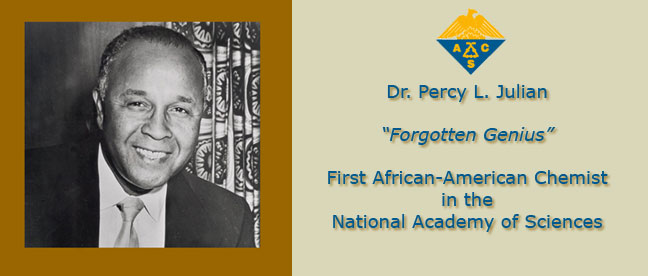
Dr. Catherine T. Hunt, President, The American Chemical Society,
in association with
Paula S. Apsell, Senior Executive Producer, NOVA,cordially invites you to attend
a reception, preview screening, and program, celebrating the premiere of
“Forgotten Genius”
NOVA's Film Biography of Dr. Percy Julian.Tuesday, January 23, 2007 - 6:30 pm to 8:30 pm
The National Academy of Sciences
2100 C Street, N.W.
Washington, DC 20037
(Enter at 21st Street; Photo ID required)RSVP Online:
http://websurveyor.net/wsb.dll/24237/percy_julian.htm
The story of Dr. Julian’s life is one of courage, dedication, perseverance and triumph against overwhelming odds. Born in 1899, the grandson of slaves, Julian overcame Jim Crow segregation and a daunting series of racial obstacles to earn advanced degrees at Harvard and the University of Vienna. He went on to become a chemist of international stature, the first African-American chemist ever elected to the National Academy of Sciences. The program will not only explore Julian's life and achievements, but the impact of industrial science on American society, and the racial obstacles that African Americans have faced in pursuing careers in science. We believe his inspiring life-story is particularly relevant for our youth, and may inspire those who had not considered a life in science to follow that path.
Percy Lavon Julian (1899-1975)*
Percy Lavon Julian was a trailblazing synthetic chemist, a successful industrial research director, and a wealthy businessman, notwithstanding the prejudices and discrimination of his time. He was born in Montgomery, AL, on April 11, 1899, the son of a railway clerk and the grandson of slaves. From the beginning, he did well in school, but there were no public high schools for African Americans in Montgomery. Dr. Julian graduated from an all-Black normal school inadequately prepared for college. Even so, in the fall of 1916, at the age of 17, he was accepted as a sub-freshman at DePauw University. Thus, in addition to his regular college courses, he took classes at a nearby high school. He also had to work to pay his college expenses. Nevertheless, he excelled. Dr. Julian was elected to Phi Beta Kappa and graduated with a B.A. degree in 1920 as valedictorian of his class. His chosen path of chemistry would prove to be a rocky one. With no encouragement to continue his education and having been denied a fellowship to pursue graduate work, he found a position as an instructor in chemistry at Fisk University in Nashville, TN.
After two years at Fisk, Dr. Julian won an Austin Fellowship to Harvard and received his M.A. degree in 1923. Again, he faced disappointment in being denied the opportunity to pursue his doctorate at Harvard. He eventually joined the staff of predominantly Black institutions, first at West Virginia State College and, in 1928, as head of the department of chemistry at Howard University in Washington, DC. In 1929, Dr. Julian received a Rockefeller Foundation grant and the opportunity to earn his doctorate. He elected to study natural products chemistry with Ernst Späth at the University of Vienna.
He received his Ph.D. in 1931 and returned to Howard, accompanied by his friend, Josef Pikl. After two years, however, internal politics forced them to leave. In 1933, through the efforts of his former professor William Blanchard, Dr. Julian returned to DePauw University as a research fellow. He taught advanced courses in organic chemistry and directed research projects for senior chemistry majors. It was here in Minshall Laboratory in 1935, in collaboration with Pikl, that he completed the research that would result in the total synthesis of physostigmine. This work established Dr. Julian’s reputation as a world-renowned chemist at age 36.
Despite his accomplishments as a recognized and published researcher, Percy Julian was denied a faculty position at DePauw. Frustrated in his efforts to gain an academic post, Dr. Julian turned to industry. One research job fell through because of a town law forbidding “housing of a Negro overnight.” Then, in 1936, a door opened when Dr. Julian was offered a position as director of research for soya products for Glidden in Chicago, IL. Over the next 18 years, the results of his soybean protein research produced numerous patents and successful products for Glidden, among them a paper coating and a fire retardant foam used widely in WWII to extinguish gasoline fires. His biomedical research made it possible to produce large quantities of synthetic progesterone and hydrocortisone at low cost.
In 1953, he established Julian Laboratories, a successful enterprise that he sold for more than $2 million in 1961. He later formed the Julian Research Institute, a nonprofit research organization. Among his many lifetime honors was election to the National Academy of Sciences in 1973. He was also widely recognized as a steadfast advocate for human rights. Dr. Julian continued his private research studies and served as a consultant to major pharmaceutical companies until his death on April 19, 1975.
*Percy Julian's biography appears on the National Historic Chemical Landmarks Web site